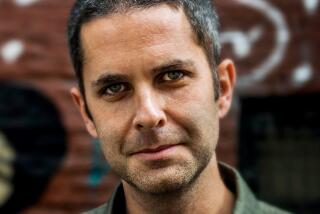Perished in His Pride : CHATTERTON <i> by Peter Ackroyd (Grove Press: $17.95; 234 pp.) </i> : THE FAMILY ROMANCE OF THE IMPOSTER POET THOMAS CHATTERTON <i> by Louise J. Kaplan (Atheneum: $22.95; 291 pp.</i> , <i> illustrated) </i>
- Share via
One of England’s more remarkable literary forgeries took place in 1768, when there were discovered in the seaport of Bristol a number of medieval manuscripts, the work of a hitherto unknown poet-priest who signed himself Thomas Rowley. Although Horace Walpole refused to publish the Rowley poems, suspecting their authenticity, other influential readers found them not only genuine but excellent poetry, and a generation would pass before the literary world agreed that they were indeed clever forgeries. The true author was one Thomas Chatterton, the 16-year-old apprentice who claimed to have discovered them in an old chest in a church attic.
The remainder of Chatterton’s brief story became romantic legend. In April, 1770, he moved to London, confident of making a name for himself as poet and political satirist. But on Aug. 25 of the same year the 17-year-old was found dead in a cheap London garret, the victim of poison and an apparent suicide.
To later poets Chatterton’s death seemed a martyrdom, a sacrifice of genius to the false gods of the marketplace. Wordsworth saw Chatterton as a “Marvelous Boy, the sleepless soul that perished in his pride.” In 1856 Henry Wallis painted the London garret, its one window open on the city, with the lifeless poet across the bed, his hand trailing across a floor littered with torn fragments of his poems.
The Chatterton of Peter Ackroyd’s novel is less a historical personage than a presence who haunts history. We begin in today’s London, with the discovery of evidence that Chatterton’s death was itself a forgery. The boy had lived to middle age, a forger of truly grand proportions, and the true author of the poems of William Blake, Thomas Gray, and others. The second movement of the novel adds the mid-Victorian episode of Henry Wallis’ painting, and his simultaneous seduction of the wife of the young poet who posed as his “Chatterton,” George Meredith. Thomas Chatterton himself appears in the last section, which describes his last day, his poisoning, and his death. Linking all three plots is Charles Wychwood, chief sleuth in the attempt to track Chatterton down and an unsuccessful poet himself. For him the dead poet becomes an obsession and eventually a kind of salvation.
To its last page the novel remains a literary detective story, the plot of which must be left to the reader. What should be said is that this remarkable and enjoyable book deserves to find readers. The parallel narratives by a gallery of characters--some parodies, some parodists--interest, amuse and touch us.
At the heart of Ackroyd’s novel, however, is a deeply serious concern with art, its relationship to the artist and to “reality.” Such questions are posed by Chatterton’s crime of forgery, and one by one the modern characters reveal themselves to be guilty of the same crime in one dimension of life or another. On all three historical horizons the word real becomes a leitmotif of dialogue and narrative, calling into question our assumptions, fashionable or naive, about the nature of the real. At one point Wordsworth’s lines on Chatterton are quoted by a well-meaning priest, who precisely reverses their meaning--as if to document the inevitability with which history converts the true into the false and vice versa. Ackroyd’s ambitious plot requires that he “forge” Chatterton, and as we might expect he does it very well.
Ackroyd’s previous book was a biography of T. S. Eliot, a poet who would, I think, have enjoyed this novel for its wit, its occasional bawdiness, its irreverences (Eliot himself is called a “sleetie” by one of the more irreverent characters). The novel inhabits history as Eliot imagined it, a realm in which art of all periods coexists simultaneously, where through form art offers a means of transcendence. One of the novel’s metaphors for such a space is London’s Tate Gallery, through which Charles walks toward Wallis’ Chatterton, past paintings that Ackroyd deftly converts into a history of Western culture. Another metaphor is the layered and repetitive structure of the novel itself. A rich variety of formal devices, too intricate to describe here, contrive patterns of recurrence that transcend the story line. The three narratives echo and elude to each other across the years, in patterns that make a fugue of history. At the center of the book is the painting and Wallis’ struggle to make it immortal. Here are his thoughts as he begins: “It was all of a piece and, in his recognition of the complete work, Wallis knew that it could never be as perfect upon the canvas as it now was in his understanding. He did not want to lose that perfect image, and yet he knew that it was only through its fall into the world that it would acquire innate reality. He took up his palette and, with a quick intake of breath, began.”
To her study of Chatterton Louise Kaplan brings the methods and assumptions of a Freudian psychoanalyst with particular interests in the psychopathology of adolescence. Briefly she emphasizes the early death of Chatterton senior, and interprets the poet’s life as a failed search for a lost father. In the Rowley imposture and the works that produced, Chatterton was able to create an ideal self and a surrogate father, a medieval merchant-philanthropist who figures largely in the poems. This therapeutic forgery was cut off by Walpole, as detection of the crime, after which Chatterton sank into an increasingly hopeless melancholia that ended in suicide.
Kaplan has studied her subject well, and she offers a detailed biography of the poet as well as informative digressions on many related subjects from the history of Chatterton’s monument to contemporary treatments for venereal disease--details that though fascinating sometimes overwhelm the “family romance” that is her subject. Considered as a plot, the search for the father is something of a cliche, and this book is at its weakest when it seems to be addressing a professional audience that sees Chatterton as a case-history that proves the psychological rule. Like any other storyteller, the psychobiographer must entertain an audience; Mammom must be served as well as Freud, himself a cunning teller of tales.
Apart from the unlikely coincidence of two ambitious books on a minor and largely forgotten poet, this pairing calls attention to a theme of much modern thought, the transcendence of history. In Kaplan’s Freudian perspective it is the abiding structure of the developing psyche that organizes history, giving Chatterton’s imposture a common ground with the adolescent gangs of today’s headlines. For Ackroyd history is transcended by art, itself born out of the fact of death. This truth has been explored since the beginning, but Ackroyd renders it young again, illuminating its shadows with wit, intelligence, and considerable beauty.
More to Read
Sign up for our Book Club newsletter
Get the latest news, events and more from the Los Angeles Times Book Club, and help us get L.A. reading and talking.
You may occasionally receive promotional content from the Los Angeles Times.








